
The Royal Pavilion, also known as the Brighton Pavilion, is a Grade I listed former royal residence located in Brighton, England. Beginning in 1787, it was built in three stages as a seaside retreat for George, Prince of Wales, who became the Prince Regent in 1811, and King George IV in 1820. It is built in the Indo-Saracenic style prevalent in India for most of the 19th century. The current appearance of the Pavilion, with its domes and minarets, is the work of architect John Nash, who extended the building starting in 1815. George IV's successors William IV, and Victoria, also used the Pavilion, but Queen Victoria decided that Osborne House should be the royal seaside retreat, and the Pavilion was sold to the city of Brighton in 1850.

Henry Holland was an architect to the English nobility.

Brighton Pavilion is a constituency represented in the House of Commons of the UK Parliament since 2010 by Caroline Lucas of the Green Party.

The Duke of York's Picture House is an art house cinema in Brighton, England, which lays claim to being the oldest cinema in continuous use in Britain. According to cinema historian Allen Eyles, the cinema "deserves to be named Britain's oldest cinema".
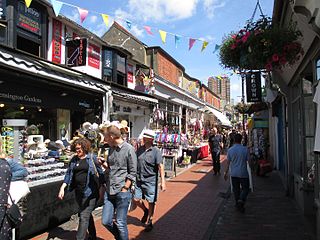
North Laine is a shopping and residential district of Brighton, on the English south coast. Once a slum area, it is now seen as Brighton's bohemian and cultural quarter, with many pubs, cafés, theatres and museums.

The Theatre Royal, Brighton is a theatre in Brighton, England presenting a range of West End and touring musicals and plays, along with performances of opera and ballet.

The Brighton Dome is an arts venue in Brighton, England, that contains the Concert Hall, the Corn Exchange and the Studio Theatre. All three venues are linked to the rest of the Royal Pavilion Estate by a tunnel to the Royal Pavilion in Pavilion Gardens and through shared corridors to Brighton Museum.
The Regent Cinema was a cinema in Brighton, England. It was opened by Provincial Cinematograph Theatres on 27 July 1921 and was one of that company's first super cinemas. It was demolished in 1974.
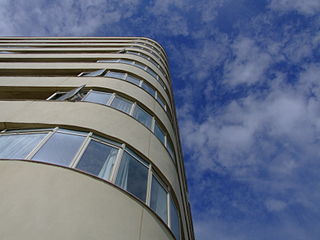
Brighton and Hove City Centre is the commercial and cultural centre of the city of Brighton. Geographically, the so-called city centre is located in an easterly part of the Brighton and Hove urban conurbation.

The Chattri is a war memorial in the English city of Brighton and Hove. It is sited 500 feet (150 m) above the city on the South Downs above the suburb of Patcham, and is accessible only by bridleway. It stands on the site where a number of Indian soldiers who fought for the British Empire were cremated during the First World War. The structure has Grade II listed status, reflecting its architectural and historic importance. In 2017, as part of the 100th anniversary of World War I, the site of the Chattri was dedicated as a Fields in Trust Centenary Field because of its local heritage and significance.

The Sassoon Mausoleum is the former grave of Sir Albert Sassoon and other members of his family, including Sir Edward Sassoon, 2nd Baronet, of Kensington Gore. It stands at 83 St. George's Road in Brighton, England. The single-storey building, which is Grade II listed, has since served as a furniture depository and an air-raid shelter, and since being purchased by a brewery in 1949 has remained a pub or bar.

Hove Museum and Art Gallery is a municipally-owned museum in the town of Hove, which is part of the larger city of Brighton and Hove in the South East of England. The museum is part of "Royal Pavilion & Museums, Brighton and Hove", and admission is free. Opened in 1927 by the Hove Corporation, the museum is located in a late 19th-century villa originally known as Brooker Hall.

The Western Pavilion is an exotically designed early 19th-century house in the centre of Brighton, part of the English city of Brighton and Hove. Local architect Amon Henry Wilds, one of the most important figures in Brighton's development from modest fishing village to fashionable seaside resort, built the distinctive two-storey house between 1827 and 1828 as his own residence, and incorporated many inventive details while paying homage to the Royal Pavilion, Brighton's most famous and distinctive building. Although the house has been altered and a shopfront inserted, it is still in residential use, and has been listed at Grade II* by English Heritage for its architectural and historical importance.

Brighton Hippodrome is an entertainment venue in the ancient centre of Brighton, part of the English city of Brighton and Hove. It has been empty and out of use since 2007, when its use as a bingo hall ceased.
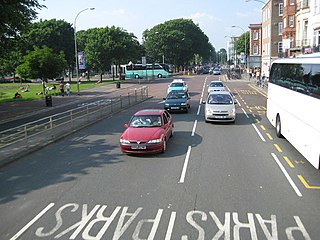
The Old Steine is a thoroughfare in central Brighton, East Sussex, and is the southern terminus of the A23. The southern end leads to Marine Parade, the Brighton seafront and the Palace Pier. The Old Steine is also the site of a number of City Centre bus stops for Brighton buses. The Royal Pavilion is located immediately to the north of the Old Steine.

The Pavilion Theatre was a theatre in Torquay, Devon, England. It was one of the three main auditoriums in Torbay, and during the 1970s differed from the Princess Theatre, Torquay, and the Festival Theatre, Paignton, in that it had plays rather than variety shows during the lucrative summer seasons.

The Opera House is a former opera house and current pub in Royal Tunbridge Wells, Kent, England. It is also a Grade II listed building.
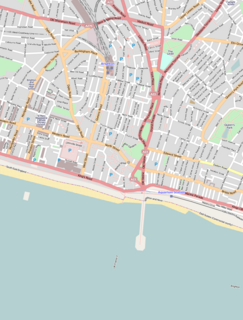
The Royal Pavilion Tavern, commonly known as the Pavilion Tavern or Pav Tav, was for nearly 200 years a pub in the centre of Brighton, part of the English coastal city of Brighton and Hove. Converted from a house into the Royal Pavilion Hotel in the early 19th century, its original role soon changed from a hotel to a pub, in which guise it remained until its closure in September 2019. The building was also used as a court for several years early in its history, and prominent local architect Amon Henry Wilds was responsible for its redesign as a hotel and inn. English Heritage has listed the building at Grade II for its architectural and historical importance, and it stands within a conservation area.
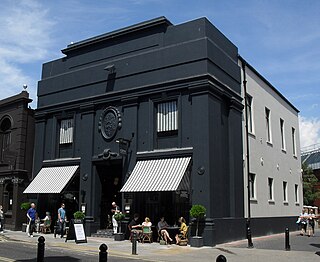
The English coastal city of Brighton and Hove has a long and varied history of libraries going back over 250 years. Subscription libraries were among the earliest buildings in the resort of Brighton, which developed in the late 18th century; by the 1780s these facilities, which were more like social clubs than conventional book-borrowing venues, were at the heart of the town's social scene. The Brighton Literary Society, its successor the Brighton Royal Literary and Scientific Institution and its rival the Sussex Scientific Institution between them established a "very fine collection" of publications by the mid-19th century, and these books were donated to the town when a public library was founded in 1871. Neighbouring Hove, originally a separate village, established its own public library in 1890.
On 26 June 1990, the Provisional IRA detonated a bomb at the Carlton Club, a club in London popular among MPs and supporters of the ruling Conservative Party. The bombing injured 20 people, one of whom, Lord Kaberry of Adel, died a year later. The ground floor collapsed to the basement and windows were shattered. The blast was felt up to half a mile away.


























